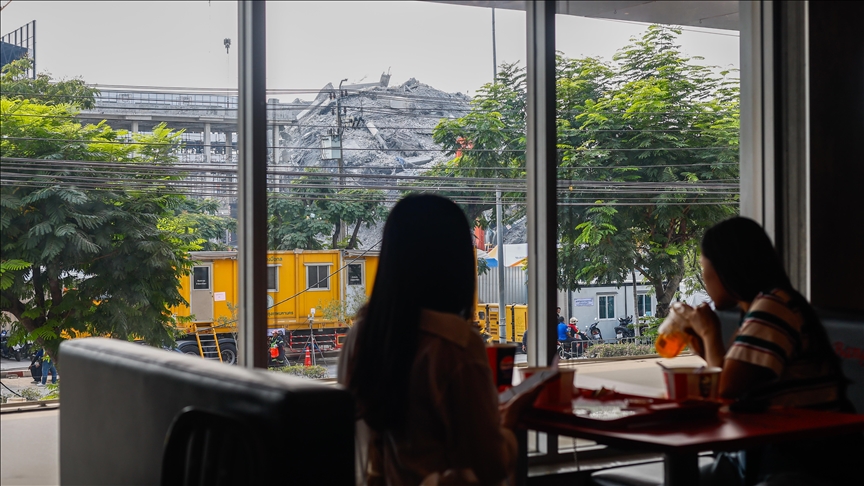Monsoon menace: Aid groups fear deadly ‘domino effect’ for Myanmar quake survivors
Humanitarian experts warn upcoming monsoon could compound suffering of survivors already grappling with loss, injury, and displacement

- Monsoon represents a huge danger as survivors do not have proper shelter, water and sanitation, or health support, says Red Cross spokesperson Tommaso Della Longa
- After this earthquake, the rains, cyclones, and floods will be like ‘a bunch of hammers hitting the same spot again and again,’ says Unni Krishnan of Plan International
ISTANBUL
As Myanmar reels from the devastating 7.7 magnitude earthquake that struck the country last week, claiming thousands of lives, aid workers and experts are now warning that the approaching monsoon season could trigger a deadly “domino effect,” compounding the suffering of survivors already grappling with loss, injury, and displacement.
With the death toll topping 3,000, hundreds still missing, and thousands injured, Friday’s quake is the deadliest natural disaster to strike Myanmar in years. Its impact has been all the greater for a country ravaged by years of civil war since the military seized power in a 2021 coup.
As humanitarian needs mount, UN officials have warned that Myanmar’s “upcoming monsoon season … will even worsen this horrendous crisis,” calling for swift global action. On Wednesday, the military declared a three-week ceasefire running until April 22 in operations against armed opposition groups for “effective rescue operations and rehabilitation.”
Along with the UN, other humanitarian organizations such as the International Federation of Red Cross and Red Crescent Societies (IFRC) have called for scaled-up aid efforts before the monsoon season begins, warning that the combination of destroyed infrastructure, inadequate shelter, and a crippled healthcare system could create a catastrophic secondary disaster.
“There is kind of a domino effect,” Tommaso Della Longa, spokesperson for the IFRC, one of the organizations involved in relief efforts in Myanmar, told Anadolu.
“Where there is no proper shelter, where there is no proper water and sanitation, where there is no proper health support, then you can have health issues … This is why we are saying it’s an utmost priority.”
Della Longa stressed that it is not enough to rescue people from the rubble, as without proper shelter and basic services, survivors will remain at risk.
In quake-hit areas, thousands are sleeping in makeshift tents or on the streets, he said, with many afraid to return to their houses due to structural damage, while others have no home to go back to.
“The monsoon danger is huge. You need to put people in safety and keep them safe,” he said.
He noted that past experience with cyclones and floods in Myanmar, including last year’s Typhoon Yagi, has shown that flimsy shelters will be unable to withstand the rains.
“We cannot predict the severity of the monsoon, but by experience, we know that these kinds of makeshift and temporary shelters are not enough to keep people safe,” he asserted.
Monsoon another ‘hammer’ for Myanmar
More than 3.5 million people were displaced in Myanmar before the quake, and nearly half of the population lives below the poverty line, with battered civilian, health, and communications networks.
Given the dire humanitarian conditions, the monsoon season will be another “hammer” poised to strike an already fragile situation, Unni Krishnan, global humanitarian director at Plan International, another key organization in the response, told Anadolu.
According to health and aid agencies, waterborne diseases like cholera, diarrhea, and typhoid pose serious threats during the rainy season, especially when communities are forced to rely on unsafe drinking water sources.
Cramped living conditions in overcrowded camps or temporary shelters also increase the risk of disease outbreaks.
“Imagine there is a fragile community. One disaster has already struck, which is an earthquake. Then you bring another one with the rains. It’s not even floods because rains themselves could trigger waterborne diseases,” said Krishnan.
“Then you bring the cyclone and the floods and the storm surge. So, you’re talking about a bunch of hammers hitting the same spot again and again.”
The monsoon downpour, which can last from June to October, “is the last thing that survivors, especially some of the most vulnerable … need at this time,” he said.
Krishnan added that the earthquake and potential weather disasters “will multiply the unmet needs” of Myanmar’s population.
Della Longa echoed the urgency, pointing out that the affected communities were already struggling to recover from last year’s flooding, while scorching heatwaves also claimed scores of lives in their areas.
‘Not a sprint, but a marathon’
Both experts emphasized that the response must go beyond immediate life-saving efforts and address long-term needs.
Della Longa noted that while international aid has gradually increased, enormous logistical hurdles are delaying the response, particularly the devastation of infrastructure like bridges and roads, as well as public services.
“We’re talking about rebuilding houses, rebuilding public services, rebuilding livelihoods … This is not a sprint; it will be a marathon, and it will be a long marathon,” he said.
Krishnan also emphasized the importance of transportation and communication, describing them as “the two engines that can drive coordination efforts and aid delivery.”
He reiterated that the fragile situation could easily worsen if another disaster – whether a cyclone, flooding, or further disease outbreaks – were to strike.
“It’s a bit of a bleak scenario. At the same time, we shouldn’t lose hope because we are also seeing how people want to engage in relief and recovery efforts,” he said.
“Any mechanism that could really galvanize those local communities and local capacities would be very crucial.”
Anadolu Agency website contains only a portion of the news stories offered to subscribers in the AA News Broadcasting System (HAS), and in summarized form. Please contact us for subscription options.







